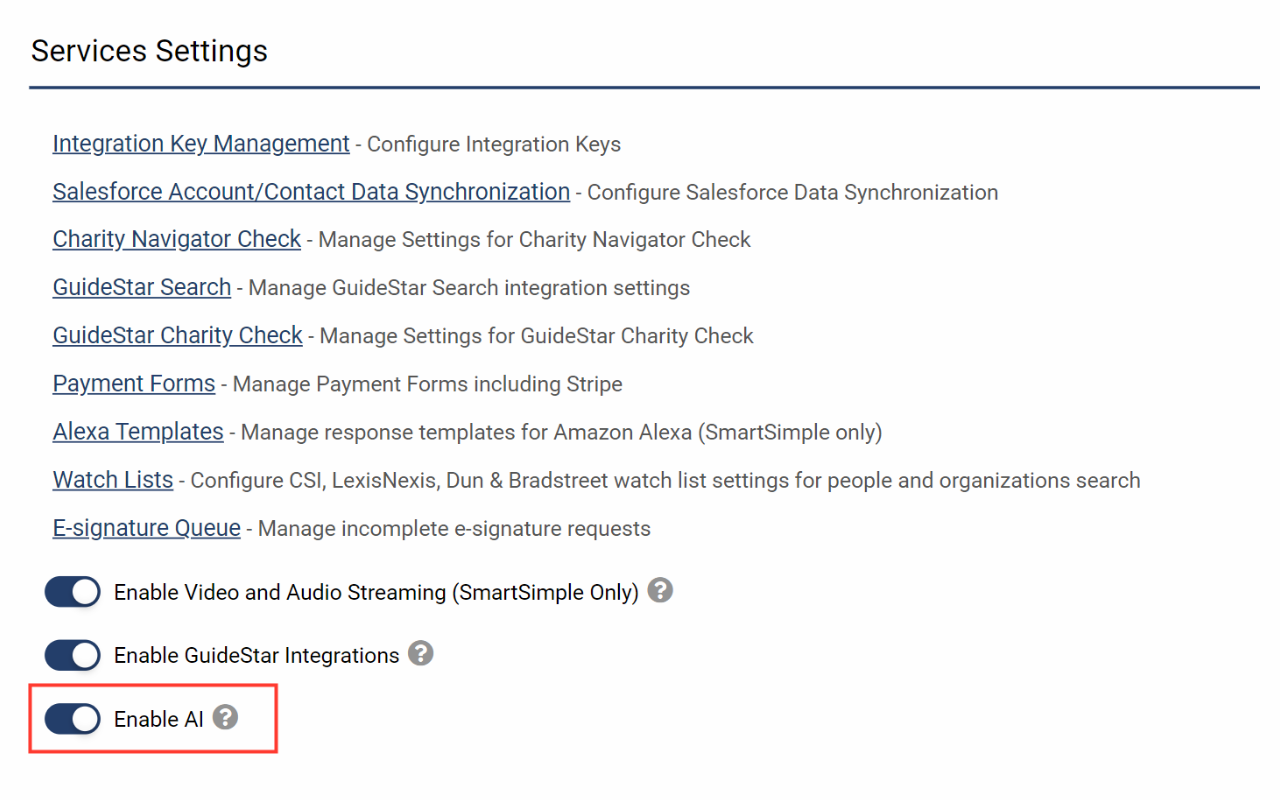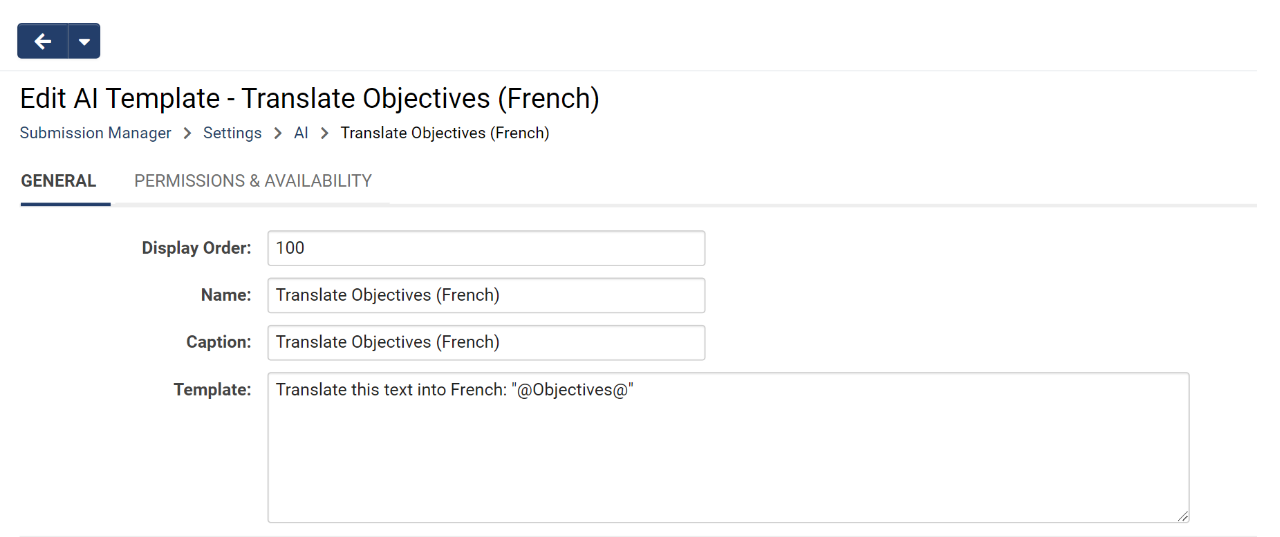Difference between revisions of "Template:AI"
Ann Vincent (talk | contribs) m |
Ann Vincent (talk | contribs) m |
||
| Line 1: | Line 1: | ||
{{Banner-UnderConstruction}} | {{Banner-UnderConstruction}} | ||
| + | |||
The SmartSimple Cloud '''+AI''' integration gives you the ability to utilize large language models (LLM) from within our business process automation platform. LLMs may be utilized to improve productivity, processes, and outcomes. This article will walk-through how-to setup the integration, outline the two modes (automation and interactive), and delineate some sample scenarios. | The SmartSimple Cloud '''+AI''' integration gives you the ability to utilize large language models (LLM) from within our business process automation platform. LLMs may be utilized to improve productivity, processes, and outcomes. This article will walk-through how-to setup the integration, outline the two modes (automation and interactive), and delineate some sample scenarios. | ||
Revision as of 15:47, 26 June 2023
The SmartSimple Cloud +AI integration gives you the ability to utilize large language models (LLM) from within our business process automation platform. LLMs may be utilized to improve productivity, processes, and outcomes. This article will walk-through how-to setup the integration, outline the two modes (automation and interactive), and delineate some sample scenarios.
Contents
Overview
There are two modes of operation when using SmartSimple Cloud +AI:
- Interactive Mode: This mode of operation occurs on a single object such as a grant application or review. In this scenario, the user can interact with the AI in a call-and-response kind of model. The user might ask the AI to help them rewrite content, translate content into another language, or make content more concise. The user can ask questions (prompts) and follow up with more related questions. The user can also be presented with optional predefined templates to streamline common tasks or actions.
- Automation Mode: This mode of operation can occur in various areas of the platform. In this scenario, the system is configured to automatically interact with your chosen 3rd party LLM vendor to do something without manual intervention. For example, the system can be configured to automatically generate an executive summary of an application or a summary of the reviewers’ comments. Applications could be prescreened and recommended or the AI could suggest reviewers with subject matter expertise related to the application.
Configuration - Essentials
Setting up +AI Integration
If you are interested in adding +AI functionality to your SmartSimple Cloud instance, reach out to your account manager or contact our Platform Solutions team. They can set up an integration key so that your SmartSimple instance is able to communicate with a third-party LLM vendor, such as OpenAI’s ChatGPT. They will be able to enable +AI by going to Global Settings > Integrations tab > Toggle on Enable AI.
Interactive Mode
The AI interactive mode is made available through the Work with +AI feature which can be enabled on nearly every record in the system, including organization profiles, user profiles, and UTA records. In this example, we can configure interactive mode on a UTA to streamline a hypothetical application process.
Configuring Interactive Mode
As an example, we can configure the AI on a particular UTA by the following steps:
- Go to UTA > Configuration Settings > Level 1/2/3 tab > AI. On this page, custom instructions and templates can be set up.
- On the Permissions & Availability tab, users can set access to the feature by role, record type, or record status.
- Click Save.
- Navigate to the desired UTA record and select Tools > Work with +AI in the top action bar. This will open a modal window into which you can enter your prompts and adjust the Temperature setting.
Setting up Templates
Templates can be created to streamline common processes. As an example, let's set up a template that will automatically translate the objectives of a record into another language. Instead of asking the AI to translate the contents this field each time, we can save our query by referencing the field as a variable.
Creating a Template
- Go to UTA > Configuration Settings > Level 1/2/3 tab > AI > Click the New Template button.
- Under the General tab, give the template a Name and a Caption. The Caption is what will be surfaced to users during template selection.
- Enter the template contents in the Template field. When referencing specific record fields, be sure to use the Field Name rather than the Caption. In our example, we can ask the AI to translate the content of a specific field into French by referencing the field name in quotations.
- Set who has access to use this template under the Permissions & Availability tab.
- Click Save.
Selecting a Template
- Go to the desired UTA record > Tools > Work with +AI.
- Select the preferred template from the dropdown.
- Set the desired Temperature. This setting controls the level of randomness desired from the AI's response. A lower number correlates to a more consistent and repeatable response.
- Click the Send button. After a moment, the AI will respond to the request.
Testing Template Prompts
When deciding which prompts to use in a template, it can be helpful to test the prompts by going to any UTA record and clicking Tools > Configuration Mode > Variable Syntax Helper. Here, you can test your expressions and see if your variables resolve correctly.
Best Practices for Prompts
Some best practices for prompt engineering have been listed by OpenAI:
- Put the instructions at the start of the prompt and use double quotation marks ( " " ) to separate the instructions from the context
- Be specific and descriptive about the desired outcome, including details about context, length, format, style, etc
- Provide an example or desired format in the prompt if necessary
Automation Mode
Configuring Automation Mode
Once +AI integration has been set up, the automation mode can be used in various areas of the system. The existing SmartSimple variable processor has been modified in order to allow you to interface with the AI server. To familiarize yourself with the syntax and possible statements, you can test the syntax using the Variable Syntax Helper by opening a object record and going to Tools > Configuration Mode > Variable Syntax Helper.
Syntax
The syntax used for prompts in web page views and workflows is:
These parameters are explained as follows:
- AI service: The AI service being used. If left empty, OpenAI will be used as default.
- AI function: Set the intended use of the input text. If the text is meant to be static, set the value to "text". If the text is meant to be edited by the AI, set the value to "edit".
- temperature: Set the desired level of randomness of the generated text, where a value of "0" is the most conservative while a value of "9" is the most random.
- instruction: Optional parameter when using the edit AI function.
Note: If the AI function parameter has been set to "edit", you must pass instructions to the instruction parameter on how the text should be edited in natural language. For example, "fix the grammar", "make this in the style of a poem", or "translate this into Japanese".
| Example Scenario | Syntax |
|---|---|
| Ask AI to write an email for a specific user | |
| Ask AI to fix the spelling of a message | |
| Ask the AI to write a grant application summary |
Configuration - Advanced
Leveraging AI for Webpage Views
Settings Explained
General Tab
The following settings are available on the General tab:
| Setting | Description |
|---|---|
| Instruction Caption | The title given to the instruction box that appears above the AI chat window. |
| Instruction Content | Any instructions to be displayed. Clicking the "Sample Instructions" link will populate this field with default instruction text. |
Template Settings
This following settings are available when creating a template:
| Setting | Description |
|---|---|
| Display Order | The order in which the template appears in the Template dropdown. |
| Name | The name of the template |
| Caption | The name of the template as it appears in the Template dropdown |
| Template | The content of the template or what you want to ask the AI to do. For example, "Summarize the project goals in 50 words or less". |









